Two big pieces of news about Japan's fiscal conditions made major headlines within a week in early August 2013. First, the government put forward the Medium-term Fiscal Plan on August 8, 2013. Then, on the very next day, came the Ministry of Finance's announcement that the government debt topped one quadrillion yen for the first time ever at the end of June 2013.
Many people may be starting to worry about the nation's fiscal future. As they try to decipher the government's fiscal reconstruction plan, it would be useful to have a deeper understanding of the characteristics observed in government debt trends in the past.
Government officials, such as those at the Cabinet Office and the Ministry of Finance who collect and analyze debt data over a long-term period, have in-depth knowledge about such characteristics. However, raw data and materials used for such analysis are not released to the public (Note 1), and it is not easy for ordinary people to access such data.
Thus, in a bid to be of help for those who are keenly interested in the long-term trends of the government debt, I would like to introduce some of the interesting aspects of Japan's public debt trends based on the data I have collected and compiled from various sources for research purposes.
Government debt trends over the past 100 years and beyond
Figure 1 shows the changes in Japan's government debt from 1885 to 2011 as a ratio to the gross domestic product (GDP) (Note 2). Government debt includes not only that owed by the central government but also that owed by municipal governments (prefectures, cities, wards, towns, and villages) (Note 3).
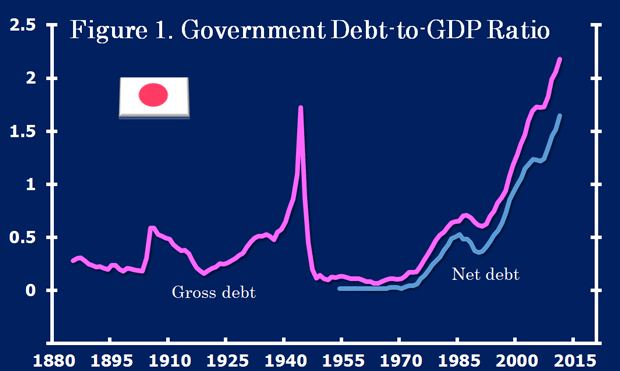
The gross government debt-to-GDP ratio, which has had ups and downs over the period, has experienced three conspicuous upward trending periods, namely, the mid-1900s; from the latter half of the 1930s to the first half of the 1940s; and from the 1990s to date. The first and second uptrends were due to a temporary increase in fiscal deficits resulting from the issuance of war bonds to finance the Russo-Japanese War and World War II respectively.
In the third and ongoing uptrend, the gross government debt-to-GDP ratio has been rising rapidly—though not as sharply as in the first two—and sustainably. This means that the rise is attributable to structural factors, namely, chronic fiscal deficits, making a striking contrast with the first two uptrends. In fiscal 2011, the ratio came close to 2.2, exceeding by far the highest record before the end of World War II, 1.7, posted in fiscal 1944.
Some scholars are critical about the use of gross debt as a measurement of the size of debt. They claim that net debt, calculated as the total amount of debt outstanding less the total value of financial assets held, should be used as a measurement because economic entities usually hold financial assets—such as cash and deposits—as well as debt. For the purpose of comparison, both gross and net debt ratios to GDP are plotted in Figure 1. We can see that they generally follow the same trend though they differ in the level.
Figure 2 shows the gross government debt-to-GDP ratios of the United States, the United Kingdom, and Japan. Both the United States and the United Kingdom experienced a temporary sharp rise in the ratio during the two world wars. However, with the end of war, the upsurge was followed by a slow but steady downtrend in each case but more conspicuously in the period subsequent to the end of World War II, in which the gross government debt-to-GDP ratio eventually returned to the pre-war level in both countries. Japan also experienced a slow but steady downtrend from the latter half of the 1900s through the first half of the 1910s following the end of the Russo-Japanese War. However, the downtrend following the end of World War II was sudden and steep, a phenomenon not seen in the United States and the United Kingdom at any time over the past several hundred years of their history.
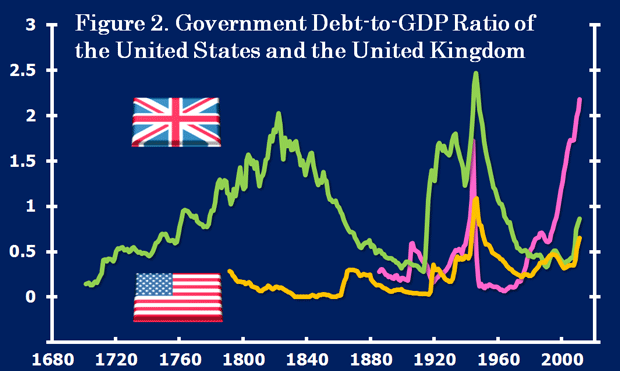
Characteristics seen in the downward trends in the government debt ratio
In Table 1, the change in the government debt ratio in each upward or downward trending period is decomposed into contributing factors (Note 4). In the periods that saw a significant rise in the ratio, as indicated by a big plus figure in the second column, the government ran a large fiscal deficit without exception, providing supporting evidence for the characteristic mentioned in the preceding section. Interestingly, however, the table shows that the downward trending periods did not necessarily coincide with a fiscal surplus. Or, more precisely, it has been rather rare for them to coincide.
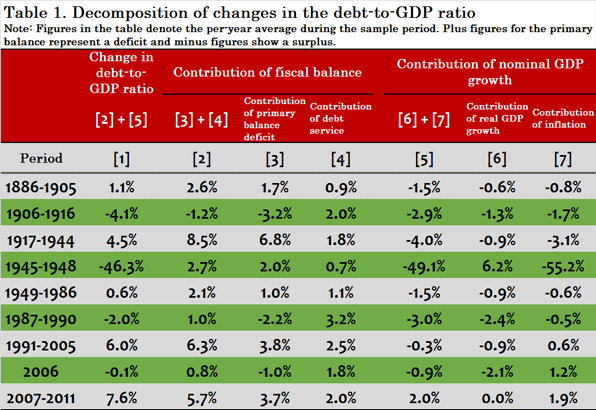
Needless to say, lowering the government debt ratio is one of the largest policy challenges for Japan. Looking into what happened in the past downward trending periods might give us hints as to how we can and should tackle this formidable challenge. Figure 3 visually illustrates the characteristics observed in some of the downward trending periods based on the numbers in Table 1.
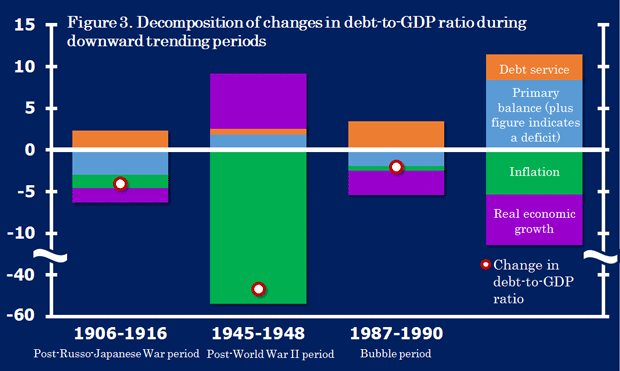
In the period following the Russo-Japanese War, a large primary balance surplus—i.e., current revenue less current expenditure excluding debt service—and sustained high economic growth on a nominal basis were the major contributing factors. The government back then implemented fiscal stimulus measures while, at the same time, maintaining strict discipline. This represents a successful case scenario for achieving a reduction in the government debt ratio by the best mix of fiscal reform measures and economic growth measures.
In contrast, the downtrend in the government debt ratio following the end of World War II was a result of a sudden fall in the yen's value which caused prices to soar and hence led to a sharp increase in nominal GDP growth. As indicated by the fact that the real GDP growth during this period of time was a contributing factor for an increase in the government debt-to-GDP ratio, the real economy was in a terrible state. This represents one of the worst case scenarios for reducing the government debt ratio.
The latter half of the 1980s resembled the period following the Russo-Japanese War in that economic growth and a primary surplus were the main contributors to the decline in the government debt ratio, but the margin of decline was smaller due to a smaller primary surplus. As Table 1 shows, Japan's government debt ratio fell only marginally in 2006. Both a marginal primary surplus that year and deflation that started in the second half of the 1990s contributed to this result.
As such, real GDP growth, inflation, and primary surplus are major contributing factors to a decline in the government debt-to-GDP ratio. If Japan is to lower the ratio, currently at a record high level, in an orthodox approach, it has no option but to make steady and continuous efforts to generate an adequate primary surplus on a sustainable basis. This is an important lesson from the history of government debt. Following the end of World War II, both the United States and the United Kingdom eventually succeeded in bringing down their high government debt ratios by making steady and continuous efforts to generate a primary surplus year after year over a long period of time.
In a bid to address the issues surrounding the first of the three contributing factors, or as a way to enhance Japan's real economic growth potential, the government of Prime Minister Shinzo Abe is vigorously promoting economic structural reform under its growth strategy dubbed as the "third arrow" of Abenomics. Meanwhile, in an attempt to end deflation and thus attain the second contributing factor, the Bank of Japan is taking bold monetary easing measures, which constitutes the "first arrow" of Abenomics. Lastly, in order to tackle problems inhibiting the achievement of a primary surplus or the third contributing factor, the government is committed to halving the primary deficit to GDP ratio by fiscal 2015 from the level in fiscal 2010 and turning the balance into a surplus by fiscal 2020, as set out in the Basic Policies for Economic and Fiscal Management and Reform endorsed by the Cabinet in June 2013.
Future outlook of the government debt-to-GDP ratio
Plotted in Figure 4 are projected ranges for the net government debt-to-GDP ratio based on several different scenarios for future primary deficits. It shows that the net government debt would remain high as a ratio to GDP even if the goal of achieving a primary surplus by fiscal 2020 is fulfilled. But the pace of rise in the debt ratio would be significantly slower than that over the period from 2002 to 2011. On the other hand, if the government fails to fulfill its goal, the debt ratio may top 2.5 times.
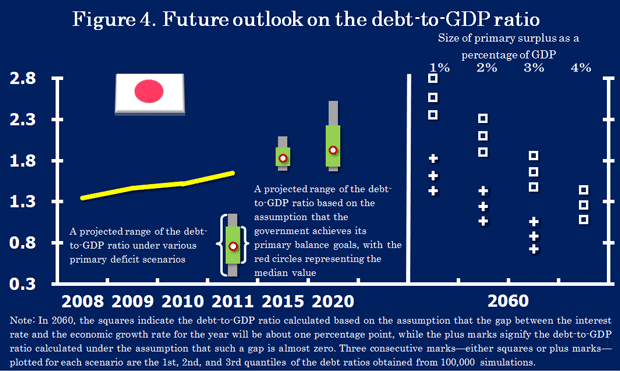
The eventual goal of the government's fiscal policy is to decrease the government debt ratio. Suppose that the government achieves its goal of turning the primary balance into a surplus by fiscal 2020 and continues to generate a surplus in the years thereafter. Then, considering that the level of future debt ratios differs depending on the assumed difference between the interest rate payable and economic growth rate in the future, the government debt ratio would be brought below the 2011 level in 2060 provided that an annual primary surplus of at least 3.5% of GDP is to be generated over the period from the latter 2020s until 2060. Bringing the ratio further down to 1.0 would take another 30 years or more based on the most conservative scenario.
Some market participants cast doubt even on the possibility of the government achieving its goal for the first milestone period through fiscal 2015. A country's primary deficit can be decreased by an increase in tax revenue resulting from economic growth as well as by discretionary policy measures such as tax hikes and spending cuts. The latter holds the key to reducing and eventually eliminating Japan's primary deficit because, as discussed above, the ongoing increase in government debt is chronic and structural in nature.
The Medium-term Fiscal Plan is expected to be revised and finalized after Prime Minister Abe makes the final decision on whether or not to raise the consumption tax in April 2014 as scheduled. The focus of attention now is whether the Abe government can come up with a convincing set of concrete and effective measures to fundamentally change Japan's fiscal and economic structure which is chronically dependent on debt.

